William Brannon
Bridging the Data Provenance Gap Across Text, Speech and Video
Dec 19, 2024



Abstract:Progress in AI is driven largely by the scale and quality of training data. Despite this, there is a deficit of empirical analysis examining the attributes of well-established datasets beyond text. In this work we conduct the largest and first-of-its-kind longitudinal audit across modalities--popular text, speech, and video datasets--from their detailed sourcing trends and use restrictions to their geographical and linguistic representation. Our manual analysis covers nearly 4000 public datasets between 1990-2024, spanning 608 languages, 798 sources, 659 organizations, and 67 countries. We find that multimodal machine learning applications have overwhelmingly turned to web-crawled, synthetic, and social media platforms, such as YouTube, for their training sets, eclipsing all other sources since 2019. Secondly, tracing the chain of dataset derivations we find that while less than 33% of datasets are restrictively licensed, over 80% of the source content in widely-used text, speech, and video datasets, carry non-commercial restrictions. Finally, counter to the rising number of languages and geographies represented in public AI training datasets, our audit demonstrates measures of relative geographical and multilingual representation have failed to significantly improve their coverage since 2013. We believe the breadth of our audit enables us to empirically examine trends in data sourcing, restrictions, and Western-centricity at an ecosystem-level, and that visibility into these questions are essential to progress in responsible AI. As a contribution to ongoing improvements in dataset transparency and responsible use, we release our entire multimodal audit, allowing practitioners to trace data provenance across text, speech, and video.
On the Relationship between Truth and Political Bias in Language Models
Sep 09, 2024Abstract:Language model alignment research often attempts to ensure that models are not only helpful and harmless, but also truthful and unbiased. However, optimizing these objectives simultaneously can obscure how improving one aspect might impact the others. In this work, we focus on analyzing the relationship between two concepts essential in both language model alignment and political science: \textit{truthfulness} and \textit{political bias}. We train reward models on various popular truthfulness datasets and subsequently evaluate their political bias. Our findings reveal that optimizing reward models for truthfulness on these datasets tends to result in a left-leaning political bias. We also find that existing open-source reward models (i.e. those trained on standard human preference datasets) already show a similar bias and that the bias is larger for larger models. These results raise important questions about both the datasets used to represent truthfulness and what language models capture about the relationship between truth and politics.
Consent in Crisis: The Rapid Decline of the AI Data Commons
Jul 24, 2024


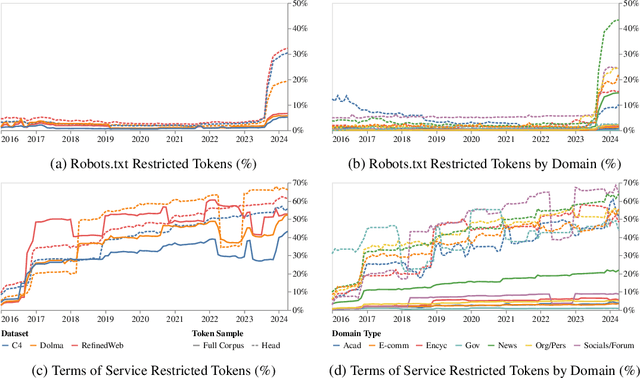
Abstract:General-purpose artificial intelligence (AI) systems are built on massive swathes of public web data, assembled into corpora such as C4, RefinedWeb, and Dolma. To our knowledge, we conduct the first, large-scale, longitudinal audit of the consent protocols for the web domains underlying AI training corpora. Our audit of 14,000 web domains provides an expansive view of crawlable web data and how codified data use preferences are changing over time. We observe a proliferation of AI-specific clauses to limit use, acute differences in restrictions on AI developers, as well as general inconsistencies between websites' expressed intentions in their Terms of Service and their robots.txt. We diagnose these as symptoms of ineffective web protocols, not designed to cope with the widespread re-purposing of the internet for AI. Our longitudinal analyses show that in a single year (2023-2024) there has been a rapid crescendo of data restrictions from web sources, rendering ~5%+ of all tokens in C4, or 28%+ of the most actively maintained, critical sources in C4, fully restricted from use. For Terms of Service crawling restrictions, a full 45% of C4 is now restricted. If respected or enforced, these restrictions are rapidly biasing the diversity, freshness, and scaling laws for general-purpose AI systems. We hope to illustrate the emerging crises in data consent, for both developers and creators. The foreclosure of much of the open web will impact not only commercial AI, but also non-commercial AI and academic research.
AudienceView: AI-Assisted Interpretation of Audience Feedback in Journalism
Jul 17, 2024

Abstract:Understanding and making use of audience feedback is important but difficult for journalists, who now face an impractically large volume of audience comments online. We introduce AudienceView, an online tool to help journalists categorize and interpret this feedback by leveraging large language models (LLMs). AudienceView identifies themes and topics, connects them back to specific comments, provides ways to visualize the sentiment and distribution of the comments, and helps users develop ideas for subsequent reporting projects. We consider how such tools can be useful in a journalist's workflow, and emphasize the importance of contextual awareness and human judgment.
Bridging Dictionary: AI-Generated Dictionary of Partisan Language Use
Jul 12, 2024
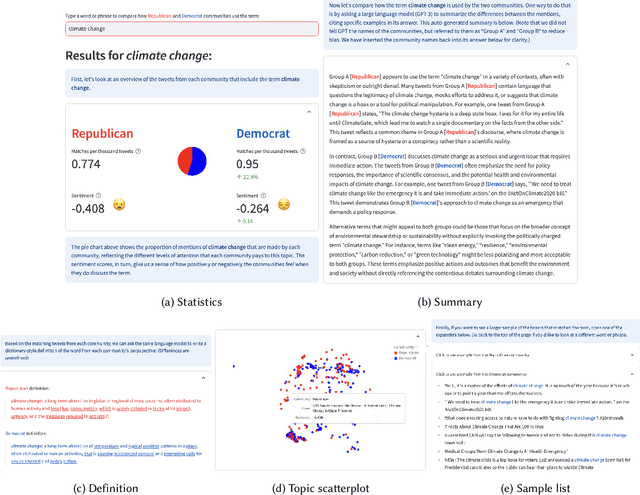
Abstract:Words often carry different meanings for people from diverse backgrounds. Today's era of social polarization demands that we choose words carefully to prevent miscommunication, especially in political communication and journalism. To address this issue, we introduce the Bridging Dictionary, an interactive tool designed to illuminate how words are perceived by people with different political views. The Bridging Dictionary includes a static, printable document featuring 796 terms with summaries generated by a large language model. These summaries highlight how the terms are used distinctively by Republicans and Democrats. Additionally, the Bridging Dictionary offers an interactive interface that lets users explore selected words, visualizing their frequency, sentiment, summaries, and examples across political divides. We present a use case for journalists and emphasize the importance of human agency and trust in further enhancing this tool. The deployed version of Bridging Dictionary is available at https://dictionary.ccc-mit.org/.
Data Authenticity, Consent, & Provenance for AI are all broken: what will it take to fix them?
Apr 19, 2024

Abstract:New capabilities in foundation models are owed in large part to massive, widely-sourced, and under-documented training data collections. Existing practices in data collection have led to challenges in documenting data transparency, tracing authenticity, verifying consent, privacy, representation, bias, copyright infringement, and the overall development of ethical and trustworthy foundation models. In response, regulation is emphasizing the need for training data transparency to understand foundation models' limitations. Based on a large-scale analysis of the foundation model training data landscape and existing solutions, we identify the missing infrastructure to facilitate responsible foundation model development practices. We examine the current shortcomings of common tools for tracing data authenticity, consent, and documentation, and outline how policymakers, developers, and data creators can facilitate responsible foundation model development by adopting universal data provenance standards.
The Data Provenance Initiative: A Large Scale Audit of Dataset Licensing & Attribution in AI
Nov 04, 2023Abstract:The race to train language models on vast, diverse, and inconsistently documented datasets has raised pressing concerns about the legal and ethical risks for practitioners. To remedy these practices threatening data transparency and understanding, we convene a multi-disciplinary effort between legal and machine learning experts to systematically audit and trace 1800+ text datasets. We develop tools and standards to trace the lineage of these datasets, from their source, creators, series of license conditions, properties, and subsequent use. Our landscape analysis highlights the sharp divides in composition and focus of commercially open vs closed datasets, with closed datasets monopolizing important categories: lower resource languages, more creative tasks, richer topic variety, newer and more synthetic training data. This points to a deepening divide in the types of data that are made available under different license conditions, and heightened implications for jurisdictional legal interpretations of copyright and fair use. We also observe frequent miscategorization of licenses on widely used dataset hosting sites, with license omission of 70%+ and error rates of 50%+. This points to a crisis in misattribution and informed use of the most popular datasets driving many recent breakthroughs. As a contribution to ongoing improvements in dataset transparency and responsible use, we release our entire audit, with an interactive UI, the Data Provenance Explorer, which allows practitioners to trace and filter on data provenance for the most popular open source finetuning data collections: www.dataprovenance.org.
ConGraT: Self-Supervised Contrastive Pretraining for Joint Graph and Text Embeddings
May 23, 2023Abstract:We propose ConGraT(Contrastive Graph-Text pretraining), a general, self-supervised method for jointly learning separate representations of texts and nodes in a parent (or ``supervening'') graph, where each text is associated with one of the nodes. Datasets fitting this paradigm are common, from social media (users and posts), to citation networks over articles, to link graphs over web pages. We expand on prior work by providing a general, self-supervised, joint pretraining method, one which does not depend on particular dataset structure or a specific task. Our method uses two separate encoders for graph nodes and texts, which are trained to align their representations within a common latent space. Training uses a batch-wise contrastive learning objective inspired by prior work on joint text and image encoding. As graphs are more structured objects than images, we also extend the training objective to incorporate information about node similarity and plausible next guesses in matching nodes and texts. Experiments on various datasets reveal that ConGraT outperforms strong baselines on various downstream tasks, including node and text category classification and link prediction. Code and certain datasets are available at https://github.com/wwbrannon/congrat.
Dubbing in Practice: A Large Scale Study of Human Localization With Insights for Automatic Dubbing
Dec 23, 2022Abstract:We investigate how humans perform the task of dubbing video content from one language into another, leveraging a novel corpus of 319.57 hours of video from 54 professionally produced titles. This is the first such large-scale study we are aware of. The results challenge a number of assumptions commonly made in both qualitative literature on human dubbing and machine-learning literature on automatic dubbing, arguing for the importance of vocal naturalness and translation quality over commonly emphasized isometric (character length) and lip-sync constraints, and for a more qualified view of the importance of isochronic (timing) constraints. We also find substantial influence of the source-side audio on human dubs through channels other than the words of the translation, pointing to the need for research on ways to preserve speech characteristics, as well as semantic transfer such as emphasis/emotion, in automatic dubbing systems.
RadioTalk: a large-scale corpus of talk radio transcripts
Jul 16, 2019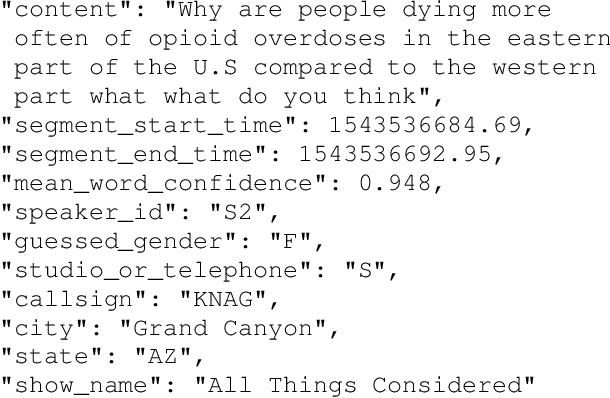
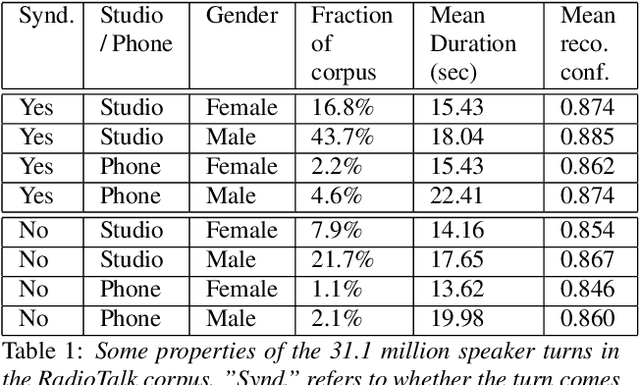
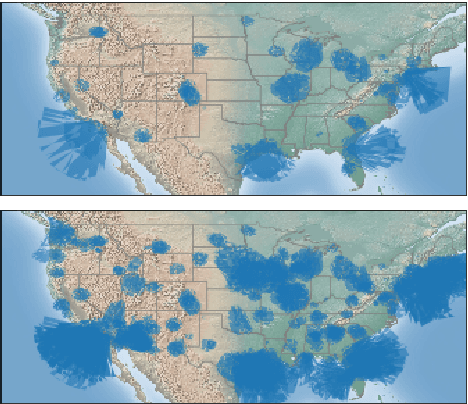

Abstract:We introduce RadioTalk, a corpus of speech recognition transcripts sampled from talk radio broadcasts in the United States between October of 2018 and March of 2019. The corpus is intended for use by researchers in the fields of natural language processing, conversational analysis, and the social sciences. The corpus encompasses approximately 2.8 billion words of automatically transcribed speech from 284,000 hours of radio, together with metadata about the speech, such as geographical location, speaker turn boundaries, gender, and radio program information. In this paper we summarize why and how we prepared the corpus, give some descriptive statistics on stations, shows and speakers, and carry out a few high-level analyses.
 Add to Chrome
Add to Chrome Add to Firefox
Add to Firefox Add to Edge
Add to Edge